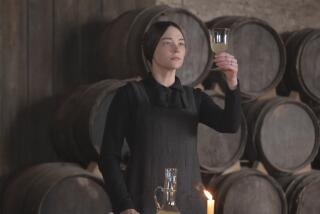It’s ‘Divorce,’ Parisian style
- Share via
The ostensible protagonists of “Le Divorce,” the new culture-clash comedy from Merchant-Ivory, are Isabel (Kate Hudson) and Roxy (Naomi Watts), two American sisters from Santa Barbara who become entangled with dashing Frenchmen while living in Paris. But it’s the City of Light itself that proves as enchanting a presence in the film as its pair of leading ladies -- dare one say, more so.
“Le Divorce,” based on the novel by Diane Johnson, “has very little plot if you think about it,” says Watts. “There’s lots of mini-plots here and there.... But Paris is so much a part of all of those things and affects these people in the different stages of their lives and marriages and love.” Paris “is almost the main character, isn’t it?” Hudson adds.
In beloved films from “Casablanca” and “Charade” to the more recent “Amelie,” Paris has often, and enduringly, been portrayed as a city of romance, where strangers meet and fall in love against the backdrop of one of the most gorgeous cities in the world. “Le Divorce” captures some of that magic, with Isabel eagerly jumping into casual affairs with Yves (Romain Duris), a young activist, and Edgar (Thierry Lhermitte), an older, married diplomat, when she comes to visit her expatriate sister in the city.
But “Le Divorce” documents heartbreak in Paris as well, as a pregnant Roxy is distraught over being left by her Parisian husband for another woman.
Roxy’s story “is about love breaking down,” Watts says. “I think it is a different way to see Paris.” That didn’t dampen Watts’ own romance with the city, however. “It’s such a beautiful city that it does bring up amorous feelings,” she says. “You’ve got all these images in your head of famous postcards of people kissing on bridges and you do yearn for that experience.”
Watts, who grew up in Australia and England, had visited Paris several times before, but never for as long as the 13-week “Le Divorce” shoot. While there, she stayed in an apartment along the Seine river. “It was a really special time because I really felt like I was living there. It was fantastic preparation for the character as well, to just consume the lifestyle as a French person.”
Director James Ivory, 75, says he developed Francophilia as an adolescent and has been traveling to Paris for more than 50 years. “It’s a place that never palls on me. I’m always struck over and over by its beauty.” Ivory and producer Ismail Merchant own an apartment in Paris (in the 6th arrondissement), and their production company, Merchant-Ivory, keeps one of its four international offices there. They have shot all or part of such films as “Quartet,” “Mr. & Mrs. Bridge,” “Jefferson in Paris,” “Surviving Picasso” and “A Soldier’s Daughter Never Cries” in the city. Merchant also wrote a cookbook, “Ismail Merchant’s Paris: Filming and Feasting in France.” He says, “I think that Paris has played a very special part in our lives.”
“People are so open in Paris about being in love,” Ivory says. “It’s not a city where people try to hide it; nor do they feel the need to flaunt it. But people are forever kissing and caressing each other.”
“It’s musical and it’s eye candy everywhere you go,” says Hudson. “The architecture is so stunning, and part of the culture is you go and you eat for hours. Everything is about it is romantic.” Hudson smiles fondly as she remembers when her husband, Chris Robinson of the Black Crowes, took her to Paris for a week the first month they dated.
“It was volatile,” she says. “The first fight we ever had was in Paris, and he left the hotel in a huff and walked the Seine, and I sat in the hotel room and ended up going down and having a coffee and a cigarette. And then we made up. It was so romantic. It was one of those moments where you go, this city’s so full of energy and part of romance is being passionate and volatile.”
However, Paris native Leslie Caron, who plays Roxy’s haughty mother-in-law, Suzanne de Persand, in “Le Divorce,” disagrees. “When you’re born somewhere, you don’t see it as romantic,” she says. Although Caron acknowledges the beauty of the city, she says, “You must remember, I saw Paris during the war. I saw Paris as the place where I went to school, as the place where I live all day long. It’s only a foreign opinion, and very American, too, that it’s a place of romance.”
Johnson, an American who divides her time between Paris and San Francisco, was inspired to write “Le Divorce” after hearing many stories in Paris of American women who came to France and married Frenchmen, only to have the relationships break up. It’s a phenomenon the filmmakers have encountered as well.
“You hear all these stories about the French husbands” having affairs and paying less attention to their wives, says Merchant. But the families don’t talk about it, and the husband keeps up appearances for family customs such as Sunday lunches.
Caron says, “I think perhaps Americans tend to marry. They have a relationship with somebody and immediately think of marriage. The French are really more careful, cynical, wise about it. ... So there’s an awful lot of people who live together for years and years, and it’s perfectly acceptable in society.”
“I think there are two sets of expectations,” says Ivory. “The French husband is expecting someone who does things in the French way and the American wife is not prepared to do that. And the American is thinking that the French husband is going to be forever romantic and uncritical and loving, and it turns out that he becomes rather fairly soon critical and picky, picking on her because she doesn’t use the right kind of sugar or doesn’t wear scarves or whatever it is, as in the book.”
Indeed, much is made in “Le Divorce” of Isabel inappropriately carrying around a gleaming red Kelly handbag, so named after Grace Kelly (cost: about $18,000), a habitual gift from Edgar to his mistresses. Caron points out that the film’s culture clash is particular to a certain snobbish, aristocratic class of Parisians who “have this notion of keeping the title, keeping the money, keeping the appearances of good behavior, keeping the social [hierarchy]....Some of those families date from the 10th century, so it’s important not to have any scandales.” Caron, who famously played the Parisian ingenue in the films “An American in Paris” and “Gigi,” was born in Paris to a French father and an American mother. She left Hollywood for England in the 1950s before moving back to Paris in the mid-1970s.
Ivory and Merchant met Caron through mutual friends many years ago and had been wanting to work together. “Le Divorce” presented an opportunity for Caron to skewer the upper-crust pretensions with which she was very familiar.
“She’s exactly of that milieu that she represents in the film,” Ivory says.
In fact, Caron’s apartment overlooks the garden of the house which was used as her character’s residence in the film, a house in which the French author Stendhal once lived.
Many French-American relationships do last, however. Ivory says one of his close friends is a Frenchman married to an American who are now both in their 70s. Merchant notes that the opulent countryside home of Suzanne in the film is owned by an American man married to a Frenchwoman.
Caron says, “The French upper class has, I would say, since the 1900s married American heiresses for the money. So a lot of those marriages did last. But there’s very often the veiled contempt for the rich American heiress who doesn’t know the very subtle rules of behavior.” In “Le Divorce,” Isabel and Roxy come from an affluent California family and part of the film’s humor comes from the tussle over a valuable Georges de La Tour painting in the divorce proceedings, exacerbated by the arrival in Paris of Isabel and Roxy’s parents (played by Sam Waterston and Stockard Channing), who speak bluntly about money matters, which -- like the affair -- the French relatives are loath to speak of openly.
“The thing I love about James’ movie is that it’s a comment but it’s not a judgment,” Watts says. It shows “in a very amusing way how different we all are. We’re all human beings and we’re all equals. No one’s superior, but look how funny it is what we trouble over versus what they do.”
More to Read
Only good movies
Get the Indie Focus newsletter, Mark Olsen's weekly guide to the world of cinema.
You may occasionally receive promotional content from the Los Angeles Times.










